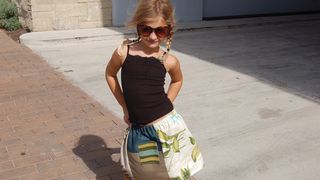The EPA has shown that in 2010, 13.1 million tons of textiles were discarded, with 85% going to a landfill. Each year, 3,000 tons of textiles are ending up in Austin’s landfills, which is a huge waste. We seek to build a business that uses some of this waste, and in doing so, will help Austin reach the goal of zero waste by 2040.
In all phases of the business, the basic steps are: 1) The raw materials (fabrics) need to be bought or gathered, transported, and then sorted by material, softness, and size. 2) The fabrics are selected for each individual product. 3) The fabric is joined together, 4) The fabric is cut to fit the pattern. 5) The cut pieces are sewn together, and then 6) the raw product is finished with labels and sizing information.
We predict three phases in the growth of our company. In the first phase, we will obtain bulk fabric samples from Austin Creative Reuse, and create small batches of pocket skirts and children’s purses for market validation. We will experiment for the best price/feature point and will use local markets like Wimberley Trade Days or a Farmer’s Market as the research, sales, and marketing solution. We will begin online sales and marketing, but will keep costs low. We think that the “99% recycled” theme, the durable construction, and the unique, whimsical design will resonate with the local Austin-area market. During the first phase, we expect to hire one additional person to help with construction. During the first phase, we will be self-funded.
In the second phase, after proven sales in the local market, we will distribute the product to local stores that feature Austin or Texas themed products. As the volume of sales increases, we will acquire fabric samples directly from interior design and upholstery businesses in Austin and explore other recycling streams. We will employ 3 employees in a small manufacturing facility in Austin. As the volume increases, we may need to seek quality funding to pay for growth of our business.
In the third phase, we will evaluate what has worked best, and will adjust the business plan to meet the strongest market need. We could expand the product line into recycled women’s skirts and accessories. We hope to expand into larger retail stores, such as Bucee’s or Cracker Barrel. We could seek fabric samples or other waste fabrics from upholstery businesses outside of Austin or perhaps the new Simple Recycling in Austin.
Erica Burns holds a Bachelor of Science from UT Austin in Textiles and Apparel Design. She has worked as a costumer for several major US Opera companies. She designs and constructs children’s clothes and has an Etsy shop where she sells them. Erica understands clothing construction and sewing equipment. She has great passion and interest in children’s clothing and a great eye for color and detail.
Steve Burns holds a Bachelor of Science from UT Austin and an MBA from Texas A&M Commerce. He currently works for Canon Nanotechnologies, Inc. as a Software Engineering Senior Manager. He has great interest in all things related to entrepreneurship and environmental responsibility. He will function as the business manager who will help guide the business in a manageable growth direction. He can also tune and repair sewing machines.
There are about 60 interior design and 56 upholstery businesses in the Austin area. These businesses receive updates from their fabric suppliers once or more per year and typically throw the samples into the landfill. We will capture this material cheaper than we would pay for wholesale fabrics. However, working with this recycling stream is more challenging than buying wholesale fabric by the bolt, and requires additional labor to process. All fabric-based products require construction (sewing) which is the majority of the cost of goods. We will pay a “living wage” ($15 or more) to all employees. We welcome students, elderly, and/or disabled people (with good coordination) and we will train them.
The fabric scraps will be diverted from the landfill. We will seek to use the lowest environmental impact possible for all operations of the business, including marketing, transportation, and construction. The manufacturing space will use low-energy lighting and other green practices. The finished goods will be durable, outlasting most competing products, which reduces the total global production, a bit.
We hope that our durable clothing is reused several times between families. We will offer a 20%-off coupon for anyone that returns the product when they are finished using it, in any condition. We will try to reuse or repurpose the products when possible, or if not possible, we will use a responsible post-consumer textile waste stream.
We have the passion to make this happen!
